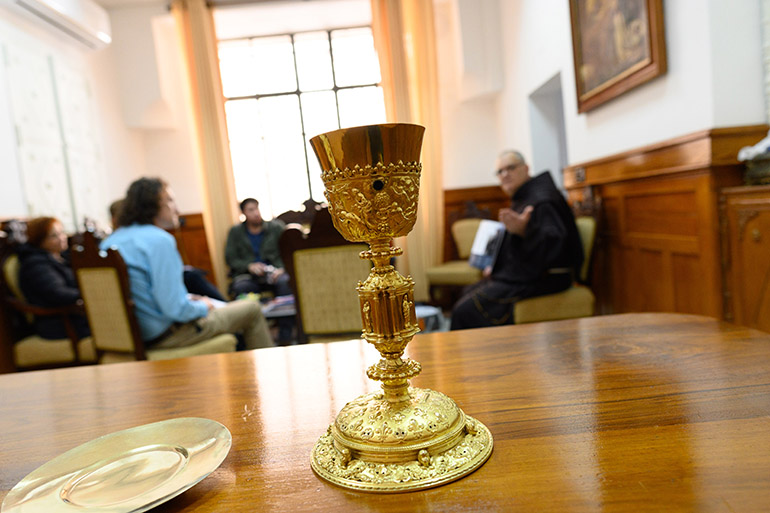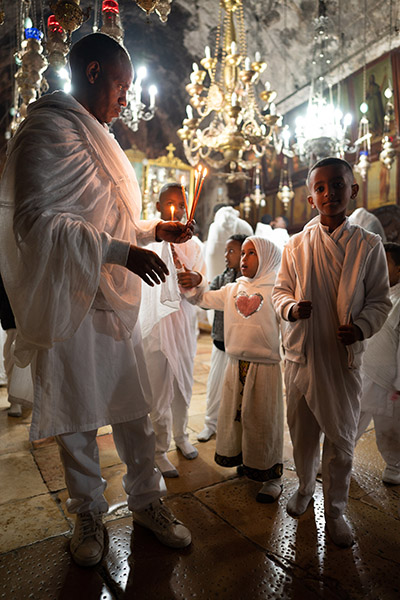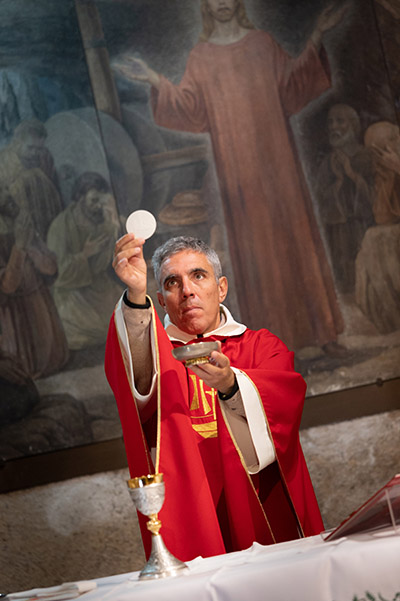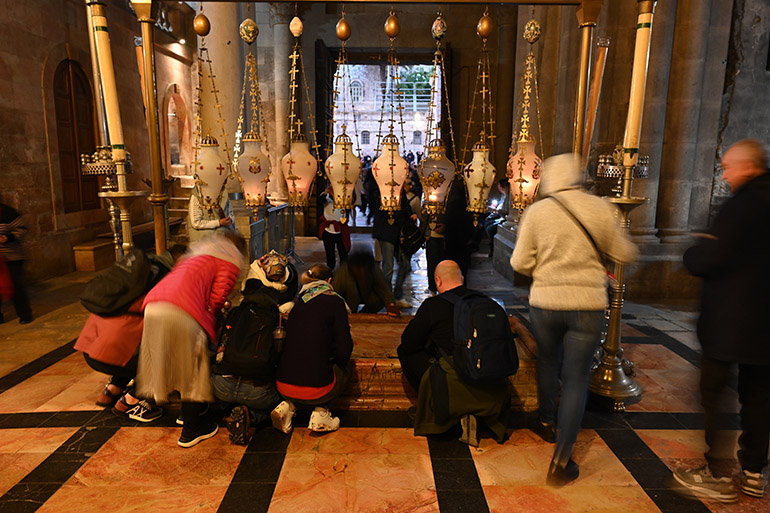By Tom Tracy - Florida Catholic

Photographer: TOM TRACY | FC
The chalice of King Louis XVI, donated to the Holy Land in 1664, is part of the historical collection at the Terra Sancta Museum in Jerusalem.
MIAMI | With Lent comes the high season for tourism in the Holy Land, as parish groups and pilgrims climb into airplanes, buses, and hotels to see the landscape and shrines of the Old and New Testament.
So it might be somewhat surprising to learn that even now, new stops are being added along the pilgrim circuit in Israel, as tourism has firmly come back following the global pandemic.

Photographer: TOM TRACY | FC
Ethiopian Orthodox Christians, one of the oldest Christian churches, pray at an Orthodox chapel near the Mount of Olives in Jerusalem in January 2023.
Israel appears to be going through another pivotal moment in its political history but religion, history and culture — rather than politics — was the focus of a press tour that I and three other Catholic media professionals joined Jan. 23-31, 2023.
The Israel Ministry of Tourism, in concert with the Catholic Media Association, hosted our small delegation of three Americans and one European on a weeklong tour of Israel’s Christian and Jewish holy places and other points of historic interest.
Like most Christian-oriented tours of the Holy Land/Israel, one part of the trip focused on the Sea of Galilee, where most of Jesus’ public ministry and miracles took place; and the other on Jerusalem, where the group stayed within walking distance of the Old City, dense with Jewish, Christian and Muslim shrines and sites.
After a welcoming dinner and stay in Tel Aviv, we walked through the Old Jaffa historic district, possibly the world’s oldest seaport and home to the picturesque St. Peter’s Church, marking the place where it is believed St. Peter raised Tabitha, one of Jesus' disciples, from the dead, according to the Acts of the Apostles.
From there we traveled north to see the historical ruins and seaside site of Caesarea, where ongoing excavations are uncovering a former Roman capital city complex including a theater, hippodrome, bathhouse and port built by King Herod the Great. Scholars believe it’s where the apostle Paul likely was imprisoned and Cornelius baptized.
Before transitioning to a hotel in Tiberias on the Sea of Galilee, the group made a stop at the Carmelite monastery on Mount Carmel overlooking the Jezreel Valley, traditional site of Elijah’s contest with the prophets of Baal.
While in the north, we also spent a few days exploring Nazareth’s Church of the Annunciation and the Lower and Upper Galilee region, including the New Testament sites of Jesus’ early ministry, such as the Mount of Beatitudes and Mount Tabor and its Church of the Transfiguration.
Something none of the delegation had seen on previous visits — and probably completely new to anyone who hasn’t been here since before the pandemic — are the excavations of the first century A.D. Jewish town of Magdala, traditional home of Mary Magdalene. The town had been lost to history until recent discoveries confirmed its location near the Sea of Galilee. The Irish-born Father Eamon Kelly, vice director of a new spiritual center there, greeted and gave an orientation to the delegation.
Before transitioning to Jerusalem, we made customary stops at the Jordan River, opposite Jericho near the Dead Sea region, and then boarded a cable car to ascend to Masada, where we saw excavations of the fortress-palace of King Herod, last stronghold in the Jewish revolt against Romans.

Photographer: TOM TRACY | FC
In Jerusalem, a priest celebrates morning Mass with a small group of Spanish clergy on pilgrimage from the Catalonia region at the end of January 2023.
In Jerusalem, the group attended morning Mass with a small group of Spanish clergy on pilgrimage from the Catalonia region before meeting up with Amit Reem, Jerusalem District archaeologist for the Israel Antiquities Authority.
Reem gave the group an overview of historical excavations across Israel, mainly in the City of David National Park and the Old City districts of Jerusalem. Particularly noteworthy: a behind-the-scenes look at the ongoing excavation of Siloam Pool and Pilgrims’ Road, located in the southern portion of the City of David and first built some 2,700 years ago.
The pool was renovated and expanded at the end of the Second Temple period – some 2,000 years ago – and believed to have been used as a ritual bath (mikveh) by pilgrims who gathered there before ascending to the Temple, according to Israeli archaeologists.
In the New Testament, the Pool of Siloam is where Jesus healed a blind man. The site is expected to eventually open to the public and become a popular City of David historical experience.
During free time and again during walking tours of Jerusalem’s Via Dolorosa, the group explored Christianity’s holiest site, the Church of the Holy Sepulchre. Located in the Old City’s Christian Quarter, the crusader-era church is administered by at least five major denominations of Christianity and marks the traditional locations of Christ’s crucifixion, death and resurrection.
Before departing Israel, the group made stops at the Terra Sancta Museum, where the Order of Friars Minor in Jerusalem is planning to expand public access to their impressive and singular collection of religious objects and artifacts.
We also toured the Israel Museum with its Dead Sea Scrolls/Shrine of the Book exhibition.
Finally, we made a stop at the relatively new Saxum Visitor Center outside Jerusalem, just coming back online since the waning of the pandemic. The Saxum Center is a kind of interfaith pilgrim welcome center, meeting space and multimedia museum experience, celebrating the Judeo-Christian foundations of the Holy Land.
Look for Tom Tracy’s individual stories on his trip to the Holy Land to be posted as a three-part series on this site in the coming weeks.

Photographer: TOM TRACY | FC
Pilgrims pass by the "Stone of Unction" at the Church of the Holy Sepulchre in Jerusalem, where tradition holds that Christ's body was laid and prepared for burial.

